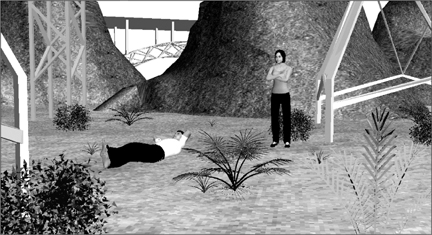
“I like the feeling of being an outsider, not directing the world I know. You come into something with a clean slate, bringing in only what you discover on your journey. I think that is a great gift afforded a movie director—that we are given access to a world that most people are forbidden to enter.”
—Sam Mendes, director, Jarhead
What is the decision-making process concerning what shots are needed to explore a scene? This is a question that faces directors from the very beginning of the directing process. Film school students are told that they must develop storyboards and shot lists and develop a shooting sequence of individual shots that comes from their imagination. They not only previsualize the shots but also when and how they want it to be edited. They go ahead and shoot the shots for the exact lines of dialogue they had imagined, thereby editing the movie before it is even shot—cutting the movie in their head. Forget that in the real world the director works with an editor and the editor knows the story only from the footage that he or she is given. Forget that the editor is only as good as the footage he or she is given. Forget that if it doesn’t work, the producer is faced with pickup shots and reshoots. Forget that pickup shots and reshoots increase the budget of the movie. Just remember that it is a mistake and incorrect directorial ideology ever to cut a scene or a movie in your head before or during your shoot. You must never cut in your head (or predetermine) but instead, as you shoot coverage, have a sense of the various ways it can be edited. Performance must motivate the camera (shot). You must never force or motivate the performance because of the camera (shot). Cutting in your head before or during the production is bad directing, and you must learn not to do that. The coverage must come from and be motivated by the performances and through how the actors are staged to elicit the performance.
Director George Stevens (Giant) would cover a scene from every conceivable angle and make his thematic and aesthetic decisions in the edit room, where he would take days to finish a scene. Of course, this is going overboard. You must come to a balance between the amount of coverage you decide to do (which serves the story and its theme and provides story choices for you and your editor) and trust in your direction that the performances are being true to the story. It is true that narrative projects are “made” in preproduction and executed during production. But “making it” in preproduction does not include predetermining how you will be editing the movie.
In Chapter 1 we discussed in detail the theme of a project and its relationship to the vision. Directors, while keeping the development of that theme and vision in mind, must first be clear as to how they are to be interpreted overall by the camera.
Boxing is a large part of the movie Annapolis, directed by Justin Lin.1 When Lin prepared this movie, he saw practically every boxing movie ever made so he could stage a fight that would present the personal journey of the protagonist, a working-class kid trying to find out who he is. Every time he stepped into the ring the audience was to get a sense of who he was as a person. Each boxing sequence had its own story carefully worked through between Lin and his cinematographer, using hand-held cameras for the close-up sequences. Lin tookthis visual style further by experimenting with shutter speeds and their thematic impact upon the audience.
Brad Silberling’s Moonlight Mile is a movie about a young man who is trying to please everyone and is in a tug of war between his dead fiancée’s parents and members of the community. In one scene, the character, played by Jake Gyllenhaal, goes to what is supposed to be a formal business dinner. Through the course of the scene it is revealed that it is a complete sham; the other people’s real purpose is to hook their daughter up with Jake Gyllenhaal’s character. There is a pretense to the premise of the scene: the scene itself is a lie, and Jake is part of that pretense and trapped in that lie and cannot get out.
There are many different ways to shoot a dinner scene, and it takes a skilled and focused director to find a visual way that supports the development of the theme. Silberling saw this dinner scene as being painfully formal, with Jake’s character caught in the middle of this strange existence. He translates this early on with his coverage when, through the open back of an empty chair, he shows a shot of Jake apparently trapped and wondering why there is an empty chair at the dinner table. When the daughter arrives and sits in the chair, there is a shot in which her head obscures a portion of Jake. Jake’s performance gives us that sense of “okay it’s a setup, it’s a trap, and I smell it, but I don’t know what it is going to be!” His performance motivates the shot. Then Silberling proceeds to show Jake isolated at the table, the subject of the parents’ hunt, yet separated from the social interaction. But if we examine the staging of the scene, another choice for coverage of Jake could have been a two-shot past actor Dabney Coleman, or any of the other characters for that matter. They were not used—and perhaps not even shot—because a two-shot would not show Jake alone as the subject of the hunt. Also, the hunt-and-hunter theme is subconsciously supported by the production design; there are paintings of animals that are caught in the hunt in the background of the shots of isolated Jake and those of his hunter, Dabney Coleman. To develop the visual to support the theme, Silberling designed all of his coverage on Jake from the daughter’s perspective and on everyone else with no one else in the frame, and because of his performance, the audience sees Jake, the hunted, easily falling out of the trap. At the end of the scene, they realize (as does Jake) that the daughter has been trapped for a long time in the same existence in her family. How does Silberling do this? By covering her from Jake’s perspective!
This scene demonstrates that directors should go to the basics: performance and staging to motivate the coverage for the scene. There are many different ways to cover a scene, and coverage should never happen in a vacuum. Directors must look to see what and how they can bring out in pictures what is happening emotionally to the characters and allow that to be the driving force for the coverage. And if you are lost in the question of which coverage shot to do next and the production crew is standing around waiting for you to make your camera decisions, it is time for you to be true to the story and go back to the characters for your bearing. You will find the path there.
You must plan ahead and have an idea of how you will cover a scene. There are approaches that help you determine the camera shots needed to tell the story from a variety of angles once the scene has been staged. One successful method is to stage a master shot as a way to rehearse the scene so everyone on the set can see how the believability of the scene plays out. And then if push comes to shove and you really get into a time crunch and are unsuccessful in completing the coverage for the scene, you have the master to revert to. This also allows your actors to experience their environment and to liberate their instinct without having the camera invade their acting space, which can happen when you cover a scene. It permits them to anchor their approach or feelings about their relationships in the scene so they can either comfortably duplicate it or build on it during the various coverage shots. In addition, the master shot becomes the “chart” that shows you intuitively how and when to cover the scene. If staged correctly and looked at carefully it will also show you the most efficient and creative way of telling the story visually. Even though you have certain shots in mind but not a complete understanding as to how to achieve them, the creation and development of the master will be your compass and guide your creative thought process, since it lets you observe the actors’ process and focus on their performances.
Creating the master shot may inspire changes to the ideas you brought to the set—inspiration is a wonderful creative ingredient for a director. The master shot, like all shots, should be motivated, as it is created by the story and what you do with the actors. It’s founded in the characters and the story’s theme and, in that sense, like all shots, should be looked at as another actor. One of the most common mistakes that new directors make is thinking that an establishing shot is a master shot when they decide on a wide-angle shot that establishes where the characters are (as opposed to who they are) and proceed to have the actors play out the scene in that wide angle. Establishing shots are not master shots, although master shots can be designed to start or end as an establishing shot.

Establishing shot (5-1)
Masters do not have to run throughout the entire scene. The scene can be broken up into dramatic beats.2 For example, if the scene you are doing is more than a page and a half and the staging of the actors shifts drastically, and you find that it serves the production schedule to do more than one master shot, find a place within the scene to end one master, do its coverage, and then pick up the other master and its coverage later in the production day. The separation point between the two masters should be a moment in the scene when one or more characters make a logical emotional transition to a new dramatic beat and the staging changes to motivate the beat. This way your actors can focus easily on the discovery of the moment for each of the two masters during coverage without concerning themselves with the rest of the scene. You may find yourself working this way when you are confronted with limitations of equipment, locations, or other elements that are beyond your control. However, this decision should be made by how the actors are playing the scene and their need for emotional continuity in their performance. Again, the performance dictates how you use the camera!
Although preferred, it is not always necessary or possible to stage a master shot. In these circumstances developed coverage will change. For example, if the scene calls for a large courtroom with plaintiffs and defendants, their attorneys, the judge, and other officials as key characters in the story, along with members of the press and a gallery of people watching the proceedings from above, it may be difficult or impossible to do a master shot of the scene without the use of a crane. And even then it will be more of an establishing shot than a master shot that shows the dramatic and emotional action of the scene. This was the case with Oliver Stone’s JFK. Again, the director goes to the basics: the characters in the story. In one courtroom scene, instead of a master, Stone shows shots of the various elements and characters that not only make up the courtroom but also relate to one another in the story while always coming back to the dramatic action with Kevin Costner, who speaks to the court and jury. In another example, the setup at the beginning of Peter Weir’s Witness shows the audience a man murdered in a bathroom. After he is found, Harrison Ford shows up to investigate. The first image after the discovery of the body is an image of Amish woman, Kelly McGillis, with her Amish son (the witness) seated next to her. There is a wash of foreground wipes, and the camera tightens very slowly on her and the boy. With this simple opening shot there is a feeling of both characters being overwhelmed by what is going on. Weir didn’t use a large master to develop the scene but for that brief moment went to emotional pictures showing the overwhelming nature of the situation, with people scurrying by and the counterpoint image of two calm people sitting in the storm of fury. That image said it all! It all comes down to the story, the theme, and its elements.
A master shot that is performed with minimal camera moves (or none at all) in which the audience observes the action, is referred to as a master. The viewpoint of the shot is as if the audience is fixed, watching the scene progress and actors move into the frame. In Tobe Hooper’s Poltergeist there is a three-page scene which is done in one shot with no coverage. It is just before the clairvoyant and the mother go into another dimension to retrieve Carol Anne. The low angle shot starts out on a tennis ball on which a number is being written, and the camera tilts up and pulls back slightly revealing a five-shot with the actors staged carefully within the frame to establish the depth of the hallway in which the scene takes place. Zelda Rubinstein, who plays a clairvoyant, walks forward from the background of the shot to the foreground into a close-up as she “feels” the energy of the house. The other characters are soft focus as we see Zelda trying to get in tune with the house, while JoBeth Williams (as Diana), under Zelda’s instructions, tries to contact her daughter. JoBeth is three-quarter body in the frame on one side of Zelda’s close up, while Craig T. Nelson as Steve (Carol Anne’s father) is full body on the other side of the close-up. To the side we see one of the paranormal technicians studying Zelda, and Beatrice Straight as (Dr. Lesh) is standing in the distance, hidden slightly by Zelda’s close-up. When Zelda tells everyone that Carol Anne is unsafe where she is, the camera pedestals down slightly, leaving room for JoBeth and Craig to make a slight movement forward toward Zelda (still soft focus). In this single shot, Zelda, still in close-up, tells Craig that he needs to be cross with Carol Anne. Craig moves toward the camera and, because he is taller than Zelda Rubenstein, the camera pedestals up, and JoBeth moves into the frame right behind Craig as we see Zelda walk to the back of the shot (up camera) toward the door to Carol Anne’s room in the background. The shot now becomes a four-shot (Beatrice Straight remains fixed where she is near the door). All the characters are soft focus except Craig, who is the largest person in the frame and facing the camera. As the scene shifts with Zelda now at the door, the camera dollys slightly past Craig to a three-shot with JoBeth in the foreground, Zelda right behind her, and Beatrice behind them as JoBeth, also facing camera, moves into a sharp focus medium close-up and talks to her daughter. When Zelda tells JoBeth to lie to her daughter to get her closer to the light, JoBeth turns her head toward Zelda, saying “I hate you.” This motivates the camera to dolly past JoBeth while pedestaling down into a medium close-up of Zelda being shared with the door to Carol Anne’s room. Zelda turns to the door and says, “Now let’s open the door!” and the camera pushes in to the door. The eye-line to establish Carol Anne in the other dimension was kept above the top portion of the frame so whenever the characters were speaking to Carol Anne they looked up in the frame. This single, carefully constructed shot uses motivated movement of the actors, the depth of field of the lens, and motivated movement of the camera to develop the emotional nature of the characters. The ensemble performances of the actors and their motivated staging—and that of the camera—keep the viewer as a participant suspended in the fear of the moment and the characters’ emotional roller coaster. Hooper chose to do the scene in one3 and keep the audience watching from one perspective with the camera.
Another type of master is one in which the camera observes the action and moves along with it while observing the scene. This is called a master that moves. The most familiar is that of actors having a conversation while walking. In this master, commonly referred to as a walk and talk, actors are motivated to stop along the route specifically for coverage purposes. When the movement stops it gives directors the opportunity for coverage before the dolly moves again, as it is difficult (but not impossible) to match coverage on a moving dolly shot. This technique lets the editor edit the coverage in between the best moving moments of the dolly shot from multiple takes that the director may do. It also lets the editor re-pace the actor’s performance, adjusting the rhythm of the scene. On one movie I directed we had a scene in which two characters were walking along a seedy street in Los Angeles, having a conversation. Cinematographer Tom Denove and I devised a master that moves dolly shot that would show the nature of the neighborhood, since it provided an important aspect of the relationships between the two characters. I staged the actors to stop at certain times as they walked, with the intention of covering the scene with over-the-shoulders and close-ups whenever they stopped. As it turned out we ran out of time because we were losing daylight and were able to get coverage at only one of the stops along the move. But this particular walk and talk master was conceived to have the actors move into a tight two-shot at the last stop along the walk, just in case we couldn’t complete our coverage. So it turned out fine. Although we didn’t have enough time to complete the coverage, we had the master to complete the story in that scene, which is what we used. The performance of the actors sustained the shot.
Another type of master is the moving master. This is when the camera is a participant, as opposed to a viewer, in the scene. In a moving master the camera and the actors move to and from one another, engaging the audience as a participant in one way or another. A moving master usually involves the camera moving in the space of one or another character, employing close-ups, medium shots, and over-the-shoulder shots. Moving masters are always intensely motivated by the movement of the actors. This type of moving master uses primarily tight shots and angles combined with motivated changes in lens depth of field to direct the audience toward one statement in the shot or another. The moving master often has actors go in and out of the camera frame while disorienting the spatial relationship for the audience. Directors, when employing this technique, must carefully think through coverage to work with this kind of master shot. In the most daring instances, there is no coverage and directors must make sure that the performance is totally sustaining. Moving masters take a long time to stage and rehearse, and they run off a lot of film stock. So they must be planned carefully.
As discussed in the previous chapter, with all masters that have movement (and especially the moving master), the last position of the shot is the most important, as it links to the next sequence or scene in the movie. So the last position of the moving master is detailed first, and all other positions are coordinated backward, with adjustments made in motivation of staging, shots, and camera position. It is always a good idea to do more than one take of any moving master shot, even when you finally get the one you want. In all probability, the speed of the shot when projected runs slower than you perceived on the set. So after you have the master shot, you should do it again and ask your dolly grip to move faster and your actors to pick up their cues. Your continuity person will be able to give you the running times of both takes; you will find that, more than likely, the faster take is the one you finally use.
Before we continue, we must first explain a concept that affects coverage deeply—crossing the line! Coverage preserves consistent screen direction through the simple logic of understanding the principles of crossing the line.
The line submits to the invisible line between the physical positioning of characters in a scene. It involves keeping the camera shots on one side of the line to safeguard consistent screen directions for all characters in a scene and makes it easier for the audience to understand the spatial relationships among the characters. This provides for the simple logic of the structure of the visual language. When this is understood, breaking that structure becomes easier. The invisible line is easy to see in a two-character scene, as each time the characters move their positions, the axis of the line shifts. But in complex scenes involving multiple characters who relate to one another and/or movement that creates physical regrouping and changes in eye-line, the scene may have more than one axis.
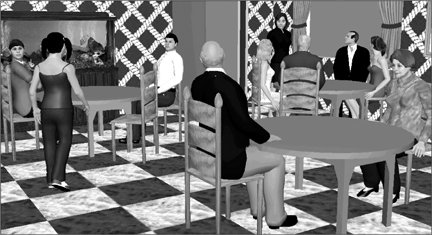
Multiple axis eye lines (5-2)
Coverage does not happen in a vacuum. There is logic to coverage, and not crossing the line is part of the logic of how the pieces need to work together. It refers to not only the way the actors’ bodies are positioned but also to the placement of the camera. It affects the spatial relationship that offers a visual logic for the audience. If you end up crossing the line with your coverage, the characters talking to each other will be looking in the same direction and will appear to not be talking to each other. One character on one side of the line is speaking facing camera right, and by crossing the line with the camera the other character is also speaking camera right. Without having either of those characters looking camera left, the physics of the scene does not work. It makes for very bad editing and is not used.
Crossing the line—also called the 180-degree rule—has a direct correlation to film editing. It refers to the fact that two characters or elements in the same scene should always have the same left/right relationship to each other. Breaking the line or the line of action is crossing the line, and in effect, if it were a multiple-camera shoot and you were crossing the line, you would see the other camera in the shot. The line extends between shots as well as it relates to any action of a character. For example, if a person exits the right side of the frame in a shot, they should enter from the left side of the frame in the next shot if it is a continuous action. Leaving from the right and entering from the right will create a disorientation of the space in which they are moving. Although the concept of crossing the line is an essential element necessary for editing, the rule is not always adhered to as sometimes the director will purposefully break the line of action in order to create disorientation. But to purposefully cross the line, the director must know what it is not to cross the line and find a way to use the disorientation thematically.
This is not to imply that the coverage may never cross the line without disorientation, because it can—but only when it is motivated. In some cases the staging of actors will take you across the line.
Karen is in a park taking a picture of a statue. From one side of the statue, Adrian approaches the scene to surprise Karen. He stands next to Karen, discussing the statue. They then move behind the statue for a picnic that Karen has arranged in the park.
When Adrian and Karen move to the blanket from their position of looking at the statue, this new angle and relatively new location can begin a new master, as it is a second beat to the scene. Although tied to the first part of the scene, the actors change their position when they move to the blanket, crossing the previous line and establishing a new line for coverage. Further, the visual cue of seeing some part of the statue from the first part of the scene ties the two locations together for the audience. In fact, if we could take the statue with us, we could shoot the second part of the scene on another shooting day in another grassy location, and the audience would think that the two locations are one, and the coverage then would maintain the line for that new master.4
The line can also be crossed by the nature of the location. For example, when Adrian stands next to Karen and they are both looking at the statue, the shot is from behind them to the statue. The reverse shot, from the statue’s point of view, is motivated, since the statue is being treated like a character because it is the focus of attention of Karen and Adrian’s conversation. In the first of those two shots, Adrian’s back is on camera left and Karen’s back is on camera right. In the second, Adrian is now camera right and Karen is camera left. When edited together, the two characters in the two shots would jump position on screen, but the physical relationship between the statue and the actors keeps the audience from being disoriented. We can also call this a reverse master, which is screen logical because of the location. But then, while looking at the statue, the coverage between the two characters would need to be from either behind them or in front of them in order to maintain logical coverage.
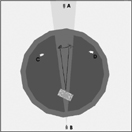
Camera positions
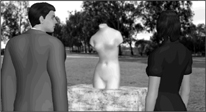
Camera A — behind them (5-3a)

Camera B — jump the line (5-3b)
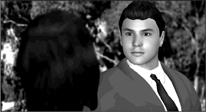
Camera C (5-3c)
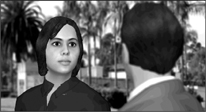
Camera D (5-3d)
Many types of locations allow you logically to cross the line. For example: a jail cell with people on one side of the bars talking to someone in jail; a window with two or more people looking out of the window and shooting them from behind (inside the room) and from the front (outside the window); a local saloon where two people are sitting at the bar talking to the bartender and shooting from behind the patrons and from the bartender’s perspective from behind the bar. In all of these cases the physical characteristic of the setting that motivates crossing the line logically helps the audience understand the physical relationships.
Eye-line is the logical continuity of the look or gaze from one character to another. Eye-line matching is based on the fact that when a character looks at someone in the off-screen space, the audience expects to see what they are looking at. Think of eye-line as the appropriate link to another character. The character is the object, the character looking is the view, and what they are seeing is the other character. Or to put it another way: the subject, the verb, and the object of a visual sentence are linked together by the trajectory of the eyes of the characters. The eye-line between characters is easily established in the wider angles. But as the coverage moves into the tighter angles, directors must maintain and adjust from shot to shot for the correct eye-line that was established in the wider angles. The adjustment for the correct eye-line is determined by the shot, the camera placement in relation to the distance and height of the subject, the depth of field of the lens, and the physical relationship of the actors to one another and to the camera. The difficulty in maintaining the appropriate eye-line comes into play when covering all sides and all angles of a scene. It becomes very difficult when there are multiple characters in the scene, as it is possible for an actor to have different eye-lines for different characters to whom they relate or with whom they have dialogue. Eye-lines are one of the most difficult concepts for new directors to master, because if not done correctly it may appear that while one character is looking into the eyes of the other character, that character is looking at the first character’s forehead. Matching eye-line creates order and meaning in the spatial relationships of the characters.

Established eye-line (5-4a)

Incorrect eye-line (5-4b)

One of the issues that affect directors (and others) during production is their perspective on the working physical space. The reality of the production space is not the reality of space that the camera creates when it is telling a story. Although the master shot generally allows for the creative environment for the actor to be played out in real time, that reality may not be seen in the shot, so the sense of the physical relationships among the actors established in the master needs to be maintained during camera coverage. But with coverage, the actual sense of space and real time shifts due to camera placement, choice of lens, and depth of field.5 This juxtaposition of film space and time is intuitive to directors in their storytelling, although it is the stuff that critical film theorists talk and write about. The camera makes its own space. So when deciding coverage and camera placement and lens size, directors and cinematographers must continually adjust and match for the spatial relationships from one coverage shot to another in terms of what the camera is seeing and not to the physical reality of the production space. This often disorients actors (especially non-camera-trained ones), which is why directors must always be cognizant of performances and be sure they are true to the story from the master and the wider angles before further coverage begins. This is because as the camera begins to move in closer to the emotional content of the characters and invade the actor’s acting space, the actor’s physical reality begins to change. And because of this they rely heavily on the judgment of the director and their own acting tools to sustain and improve their performances as their physical reality shifts.
New directors too often get lost in the physical reality of the production space, thinking it is being duplicated in the camera. But the camera images that make up coverage create their own space, and directors must not be deceived by their own sense of the physical realities of space during production. The camera image makes its own spatial associations. If the spatial aspect of where one character is in relation to another character is different through the various coverage shots, then eye-line will shift. And as we have already stated, if the eye-line shifts from shot to shot, it will be difficult for an audience to know where people are in a scene. If you decide on the wrong lens or put the camera in the wrong position as it affects the lens, you may again have one character looking at the forehead of another character and not at the other character’s eyes. It is important for you—and even more important for your cinematographer—to know and understand the depth of field of fixed lenses and variable focal length lenses and to understand how and where the camera needs to be placed for coverage. It is not a matter of plopping the camera down a few feet from the actor to get a close-up or a medium shot, which is the practice in the “gun and run” or “shoot from the hip” style of directing. This way of working violates all aesthetics for good performances of both the actor and the camera. Although lenses are primarily the domain of the cinematographer, directors must have the knowledge to communicate with their cinematographer. Lenses and camera position help the director tell the story, and the movie’s cinematographer interprets it visually for and with the director.
Coverage is essential in directing, as it offers the director and editor choices for dramatic and emotional nuances to the story. For example, it can allow for or create the expansion of an emotional or dramatic moment between characters that we may see only briefly in a master shot.
A scene takes place in a tunnel within a baseball stadium after a World Series game. Darren, the team hothead, is leaning on one side of the tunnel wall, bouncing a ball against the opposite wall of the tunnel. James, his teammate, comes walking down the tunnel to confront Darren about a fight in the dugout that happened during the game. As he approaches Darren, he stops for a moment and just looks at him. Darren stops bouncing the ball, looks at James, regretting the conversation to come, then moves to a bench sitting against the opposite wall. James walks over and sits next to him.
The shot is a wide-angle master two-shot shooting down the tunnel and showing the baseball field in the background. Darren is in profile in the foreground, bouncing the ball horizontally across the frame, and James is entering the tunnel toward camera. When Darren moves to sit on the bench and James moves to sit next to him, the camera dollies in to the two characters, making it a shared medium two-shot.
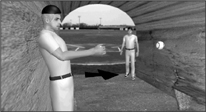
Diagonal two-shot (5-5a)
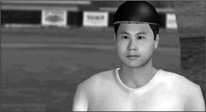
Medium close-up James (5-5b)
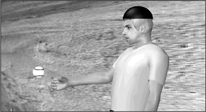
Medium shot Darren (POV) (5-5c)
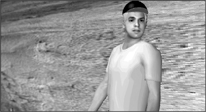
Darren looks up (5-5c)
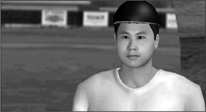
Medium close-up James (5-5b)
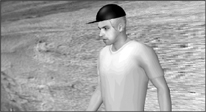
Medium shot Darren crossing (5-5c)
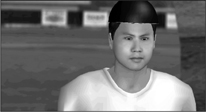
Medium close-up James crossing (5-5b)
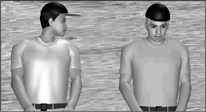
Two-shot (5-5a)
The action plays very quickly, but there is a brief moment of recognition between the two men at first meeting and a resolution in Darren to move somewhere and sit to have the dreaded conversation with James. The shot plays as it is, and since it is the beginning of the scene may very well be the choice for the final edit of the scene. But if we shoot a medium shot of Darren from James’s perspective as Darren bounces the ball, stops and looks at James, and then crosses to the bench, and shoot a tight shot of James as he stops in the tunnel and looks at Darren and then moves out of the shot and crosses to the bench, the editor will be able to expand that moment of emotional recognition and heighten Darren’s trepidation. And since the shot of James is tighter than the shot of Darren, the emotional emphasis will be on James at that moment. The closer the camera gets to the subject, the more (inner) truth it tells. You need only to look to the Odessa Steps sequence in Eisenstein’s Battleship Potemkin to see what having choices of images—which today we call coverage—can do to heighten a scene and expand an emotional moment.
First of all, there is no “standard” camera coverage setup. The coverage of a dramatic scene is dictated by the theme, the emotional elements of the characters, the actors’ performances, and the choreographic staging of the actors in relation to the camera. And since coverage does not happen in a vacuum, there is a logic to camera coverage with some basic rules to remember:
Do not cut (predetermine) in your head but have a sense of coverage or how a scene can be edited.
Do not cut (predetermine) in your head but have a sense of coverage or how a scene can be edited.
Do not cut (predetermine) in your head but have a sense of coverage or how a scene can be edited.
Now that that issue is clear, there are other concerns to remember:
Avoid taking two or more shots of the same size from the same angle or approximate angle thinking they are different; the editor will use only one of them. Don’t waste valuable time duplicating a shot. Coverage must be looked at very carefully, and no two shots should ever say the same thing. Each must say something different in terms of its relationship to the story, its emotional character content, or its theme.
Establish depth within the composition of the shot for what is essentially a flat picture. Establishing depth is done not only through production design and lighting but also through diagonal staging; using foreground, middle ground, and background objects or characters in the frame; camera movement or camera positioning; and lens depth of field. Just as actors try to create dimensions to their characters, the camera image should also establish dimensions. Together they will impact the magnitude of your story, making you a superior storyteller.
In creating coverage, always move the camera from one shot to another. Never merely adjust the lens to a different depth of field, as this will offer inaccurate eye-lines and most likely cause a jump cut,6 editorially.
Although individual shots have internal motivations—such as movement of the actors to encourage movement of the camera—all coverage shots (whether moving or not) are motivated by the story, the characters, or the theme and are either subjective or objective. It is by the use of objective and subjective shots that directors are able to manipulate the emotional connection with the audience. But most important, do not cut in your head.
The previous chapter introduced subjective and objective shots. With coverage, directors consider the degrees of subjectivity and how they relate to the logical sequence of shots that cover a scene and tell the story. First, let’s look at a simple scene in which two characters are facing and speaking to each other.

Medium two-shot 90 degrees (A)

Medium two-shot 65 degrees (B)

Medium two-shot 45 degrees (C)

Medium OS shot 20 degrees (D)

Dirty single 15 degrees (E)

Close -up 5 degrees (F) (5-6 series)
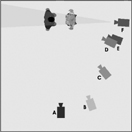
Camera positions
On one side of the diagram you can see the space contiguous to Sandra and the 45-degree area that is considered Sandra’s space. Note the camera’s positions for the series of two-shots as it moves to look over Sandra’s shoulder to her friend Eyan, with whom she is having a conversation. You will see that in each of the shots, as the camera moves closer to Sandra’s head (the apex of the 45-degree triangle), the eye-line in the images from Eyan to Sandra move from being objective to subjective until in the final over-the-shoulder shot the audience is very much in Sandra’s space. All the shots tell us that Sandra is on the right side of the frame, but with the most objective shot the audience is observing the conversation and with the most subjective shot the audience is participating in the conversation as if they were Sandra. Although the shot is over Sandra’s shoulder to Eyan, his eye-line to Sandra leaves the audience in the psychological space of Sandra bringing them closer to the relationship of the two characters. The same would hold true if it were a close-up, with one exception. Having Eyan and Sandra in the frame at the same time in a two-shot and seeing the eye-line between them at the same time illustrates to the audience the physical relationship of one character to another. In the close-up it is only the eye-line that maintains the characters’ physical relationship. Appropriate coverage from the over-the-shoulder to the close-up shot requires moving the close-up shot closer to the apex of the axis than the over-the-shoulder shot, with Eyan still looking camera right but more to the right side of the center of the frame. Sandra’s close-up would be looking camera left, with the eye-line at the correct matching placement in the frame. The camera position and lens depth of field should match from both sides if possible to preserve the correct eye-line.
Other factors may affect coverage, such as the height of the actors. For example, if Eyan is shorter than Sandra, her over-the-shoulder shot might not be over her shoulder but past her shoulder, moving on the same 45-degree axis. Eyan’s eye-line will be looking camera right, slightly toward the upper right side of the frame because of Sandra’s height. But when his close-up is shot, the camera is raised up higher than the over-the-shoulder shot, past the shoulder, so that it approximates what Sandra is seeing from her height. Eyan would still be looking up in the frame, but not as far up as the past-the-shoulder shot. His eye-line must establish his physical relationship to Sandra and the fact that she is taller than he is. The opposite would take place with the coverage to Sandra.
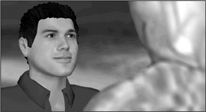
(5-7a)

(5-7b)
The cinematographer and the director decide camera placement and therefore determine how objective or subjective the coverage shots will be. If the director wants the audience to “view” or “nearly view” the scene, the shot will be objective and the camera will be placed somewhere in the outside ranges of the 45-degree angle. As the coverage for the sequence goes further and further into the relationship of the two characters, the subjectivity increases and the camera positions adjust for that subjective increase. For example, if the director wants to begin the scene with the audience observing the action, the medium two-shot will be just outside the 45-degree angle; then, as the dynamics of the scene and the intensity of the conflict in the relationship increase, the over-the-shoulder shot would be further within the 45-degree angle; finally, to bring the audience into the intensity between the characters, the close-up moves closer to the apex within the 45-degree angle. This would be duplicated for the other character, though perhaps not repeating the objective medium two-shot since we try to avoid shots from the same approximate angle. Besides, the dynamic coverage is in the subjective shots. This series of shots between two characters addresses to the theme of the scene and the director’s interpretive vision, as it pulls the audience into the emotional context of the characters while at the same time providing for many editorial choices.

Camera positions

Can you find which camera in the floor plan above is shooting which shot? (Answer on CD-ROM) (5-8 series)
A word on camera placement for the close-up: as mentioned before, actors’ performances must be securely in place once the camera position invades their acting space, since the camera shifts their sense of environmental reality. Camera position for the clean close-up is generally considered the most invasive moment of the actor’s performance. Since eye-line is critical in this close-up, directors must find the right eye-line that sets the spatial relationships between characters. In so doing, they position the camera as if it is the character seeing the close-up, and the actor whom the camera is replacing is placed somewhere on the appropriate side of the camera so that the actor whose close-up is being shot has not only the correct eye-line but also their acting partner to play to in the scene. However, that actor placement can be awkward for achieving the correct eye-line, depending on the distance of the camera from the talent and the depth of field of the lens. The acting partner may need to be positioned directly behind the lens (but to the appropriate side of the camera), or the actor in the close-up may need to look at their acting partner’s shoulder nearest the camera for the correct eye-line (or at a piece of colored tape placed on the outside perimeter of the camera lens). In these cases, the close-up is difficult for all but the most skilled actors. In the event you decide to shoot the close-up with a very long lens, moving the camera farther away from the actor, and should you be able to put the acting partner closer to the actor, the actor’s movements in close-up will still be restricted due to the very narrow depth of field of the lens. The bottom line here is to recognize that in order to achieve the close-up shot you must alter the reality for your actors.7
As we have mentioned previously, coverage has logic. Its motivations come from the staging, the actors’ performances, and the master shot (if one is used). For example, Edward Albee’s play The Zoo Story is about a man (Jerry) who, consumed with loneliness, starts up a conversation with another man (Peter) on a bench in Central Park and eventually forces him to participate in an act of violence. At some point during the staging of this scene, Peter is trying to read his book while Jerry is carrying on a conversation with him. In all probability, the actor playing Peter will be looking at Jerry sometimes and looking at his book other times. The fact that Peter’s eye-line shifts in the scene from Jerry to the book provides a motivation to do two head-on separate close-ups,8 a subjective one from Jerry’s perspective and an objective one away from Jerry but subjective from the book’s perspective. Each close-up means something different in relation to the scene; the first relates to Jerry, and the second does not. And in the editing phase of the project, the power of a close-up lies with the shots that come before it and after it, rather than in the close-up itself.9
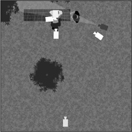
Camera positions
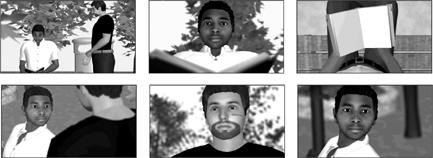
Can you find which camera in the floor plan above is shooting which shot? (Answer on CD-ROM) (5-9 series)
Directors need to go to the basics to decide what the coverage will be. The theme of the movie or scene, the staging of the actors, the emotional characteristics of the performances, and the master shot (if any) will always provide the route for coverage. Coverage can be simple or complex depending on how the sequence is conceived. Often the scene itself will define the complexity of the coverage; preconceptualized shots can cause problems by forcing the actors into the preconceived camera frames. The director must see the scene staged to actualize how it will be covered. And with luck the preconceptualized idea will manifest itself.
Coverage of a scene changes as more characters are added, and eye-lines shift as the characters relate to one another. The first coverage shot of multiple-character scenes may define the remaining coverage in telling the story. Efficient creative directors understand how one coverage shot can be used (as opposed to “will be used”) with another shot without cutting in their heads to tell the story. And it is the director’s obligation always to tell the story.
From across the street, Robert sees Will and Maggie waiting for him so they can go off to dinner. He crosses the street to join them. Will is about to get into an argument with Robert about his relationship with Maggie, but Maggie stops him and suggests they go to a quiet café to discuss things. They all agree and continue down the street to the café where Will is the executive chef.
The director stages the scene with Robert walking across the street as he sees Will and Maggie on the street corner. The master shot begins on Robert in a wide angle to show him crossing the street; the camera stays with Robert as he becomes larger in the frame and then pans and dollies right to a reveal three-shot with Robert crossing to Will and Maggie. The eye-line for Robert to Maggie and Will is from camera right to left, and for Maggie and Will to Robert it is left to right. The scene has only a few lines of dialogue before the three characters move down the street to the café.
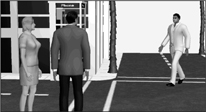
The master shot (5-10a)
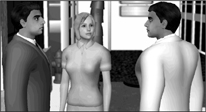
(5-10b)
The first coverage shot the director decides to do is one that he previsualized and storyboarded before staging the actors because he liked the visual composition; it is a three-shot. The camera is placed behind and between Maggie and Will so that the image is an over-their-shoulder shot to Robert, with Robert in the center of the frame, Maggie’s back on camera left, and Will’s back on camera right. Because we overlap action, the actor playing Robert steps into the shot and speaks to Maggie and Will, after which the three of them exit camera left. In this shot, Robert’s eye-line is camera left for Maggie and camera right for Will.
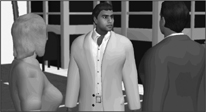
(5-10c)
The master tells us from which direction the coverage ought to go; the first coverage shot on a three-(or more) character scene may define the choices for the remaining coverage shots in telling the story. As mentioned before, efficient directors understand how one coverage shot can be used with another shot without cutting in their heads to tell the story. Keeping this in mind, we can see that this over-their-shoulder three-shot is problematic for any close-up coverage when used with the described master, since it changes the eye-lines that establish the physical relationships among the characters. Using the second three-shot will force the director to shoot coverage so that Robert is always looking camera left for Maggie and camera right for Will. The editor cannot go back invisibly to the master to establish the three characters’ physical relationship. It also means that Maggie’s close-up coverage will be camera right for Robert and camera left for Will. And Will’s close-up coverage will be camera left for Robert and camera right for Maggie. The eye-lines between Maggie and Will in this coverage sequence also become critical in establishing where they are in relation to one another and to Robert, since the physical relationship in the master does not and cannot apply here. If this all looks very confusing, it can be!
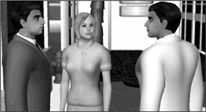
Master (5-10b)
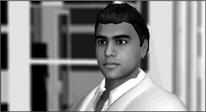
Medium single — Robert (5-10d)
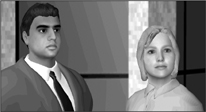
Two-shot — Will and Maggie (5-10e)
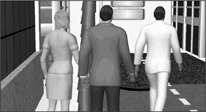
Three-shot (5-10b)
This coverage could have been kept very simple if the two-character over-the-shoulder shot to Robert was eliminated from the coverage series, as it was an unnecessary (and confusing) medium shot of Robert. Why? Because the scene is a short scene and moves quickly. Instead, a medium shot of Robert looking camera left and a medium two-shot of Will and Maggie looking to Robert camera right would be simpler and more efficient. Closer coverage could then be contained to Robert always looking camera left and Will or Maggie always looking camera right, with the two different appropriate eye-lines in their close-ups to establish where Maggie is to Will and where they are to each other. The scene is a short scene and would not require much more than this. The emphasis toward character can be positioned by the amount of subjectivity in the shots.10 The director needs to save that “special three-character over-their-shoulders shot” for another time.11
In the next scene in the movie, Maggie, Will and Robert are sitting at a café having dinner. The coverage for the scene will depend not only on what their relationship is to one another but also on where they are sitting. Are they in a booth? Are they sitting at a round, square, or rectangular table? Are they at a sushi bar? All of these things the director, and only the director, must take into consideration. For staging towards the thematic elements of the story motivates how the camerawork and coverage is designed. The technical issues of eye-line, crossing the line, and spatial relationships are also issues for a director to consider, but they come from the staging and are concerns of the cinematographer and the continuity person on the production set as well.
CHAPTER FIVE SUMMARY
 Directors must never cut in their head but instead must have a sense of montage.
Directors must never cut in their head but instead must have a sense of montage.
 Coverage never happens in a vacuum.
Coverage never happens in a vacuum.
 Actor performance and staging motivate the coverage for a scene.
Actor performance and staging motivate the coverage for a scene.
 The master shot is the “chart” that directors use to cover a scene.
The master shot is the “chart” that directors use to cover a scene.
 Creating the master shot may inspire changes to the ideas you bring to the set.
Creating the master shot may inspire changes to the ideas you bring to the set.
 Masters do not have to run throughout the entire scene. They can be broken up in terms of beats.
Masters do not have to run throughout the entire scene. They can be broken up in terms of beats.
 A master shot that observes the action and moves along with it while observing is called a master that moves.
A master shot that observes the action and moves along with it while observing is called a master that moves.
 The moving master image participates as a character rather than as an observer.
The moving master image participates as a character rather than as an observer.
 Coverage preserves consistent screen direction through the simple logic of understanding the principles of crossing the line.
Coverage preserves consistent screen direction through the simple logic of understanding the principles of crossing the line.
 Eye-line is the logical continuity of the look from one character to another.
Eye-line is the logical continuity of the look from one character to another.
 The adjustment for correct eye-line is decided by the camera position, the depth of field of the lens, and the physical placement of the actors and the camera.
The adjustment for correct eye-line is decided by the camera position, the depth of field of the lens, and the physical placement of the actors and the camera.
 The camera makes its own space.
The camera makes its own space.
 Coverage must continually adjust for the spatial relationships from one shot to another in terms of what the camera sees and not the physical reality of the production space.
Coverage must continually adjust for the spatial relationships from one shot to another in terms of what the camera sees and not the physical reality of the production space.
 Coverage can expand the emotional or dramatic moment between characters.
Coverage can expand the emotional or dramatic moment between characters.
 Avoid two or more shots of the same size from the same or approximate angle.
Avoid two or more shots of the same size from the same or approximate angle.
 Establish depth within the composition of the shot.
Establish depth within the composition of the shot.
 In creating coverage, always move the camera from one shot to another.
In creating coverage, always move the camera from one shot to another.
 All coverage shots are either subjective or objective and motivated by story, characters, or theme.
All coverage shots are either subjective or objective and motivated by story, characters, or theme.
 There are various degrees of shot subjectivity and objectivity, and each has a different impact on the audience.
There are various degrees of shot subjectivity and objectivity, and each has a different impact on the audience.
 Directors must see scenes staged to actualize how they will be covered.
Directors must see scenes staged to actualize how they will be covered.
 Coverage becomes more complex with more than two characters in a scene.
Coverage becomes more complex with more than two characters in a scene.
 With multiple-character scenes, the first coverage shot after the master sets the course for all coverage shots.
With multiple-character scenes, the first coverage shot after the master sets the course for all coverage shots.
1Publisher’s note: Justin Lin received his training as a director from the author while a student at UCLA. He also was his teaching assistant in advanced courses in directing.
2A dramatic beat is a section of dialogue in which the characters are relating to one another emotionally or on one subject and the dialogue takes a turn, indicating a change in the emotional beat. It can also be a section of a scene when one character exits or another character enters.
3“In one” is a term referred to when a director makes a decision to do a single shot for a scene without any coverage. It is often used when you need a shot such as a person walking down the street. The choice for an “in one” shot is determined by the director and is usually done to save time in production on sequences that are not important moments to the story but move the story along.
4The audience knows only that which you show them through the lens of the camera, not how it got there! And if need be, the camera can create its own location.
5Depth of field is the zone of sharp focus in front of, behind, and around the subject on which the lens is focused. Depth of field is governed by three factors: aperture, lens focal length, and shooting distance. The smaller the aperture, the greater the depth of field. The shorter the lens focal length, the greater the depth of field. The greater the shooting distance, the greater the depth of field. Depth of field is generally deeper in the background than in the foreground. And depth of field decreases with increasing focal length.
6A jump cut is a transition between two shots in which the image appears to jump, caused by frames that are quite similar. It sets the place above the action, which is contrary to the logic of narrative storytelling. By cutting out the part of the continuity as it relates to screen time, it shows the actor in a similar position in the same frame. Jump cuts can work into the style of the storytelling as in Wayne Kramer’s The Cooler.
7In Flight Plan with Jody Foster, the director does a 360-degree medium close-up dolly shot around Jody when she is looking for her missing daughter in the airport. This one shot totally breaks the actor’s sense of reality, but her skill and imagination keep her in the moment of truth.
8The actor playing the role of Peter must do the moves from the book to Jerry in exactly the same spot on each take for matching and coverage purposes.
9The constant intercutting of close-ups in a scene may weaken the visual dramatic intent of the close-up, which is to convey the emotional expression of the characters.
10In Closer, Mike Nichols covers a three-character scene in which he develops two separate two-character over-the-shoulder shots: over Julia Roberts’s shoulder to Jude Law and Natalie Portman. One is more subjective than the other. The most subjective two-shot is edited during moments of the scene that develop the secret relationship between Julia Roberts and Jude Law.
11In Jarhead, Sam Mendes uses this shot as his master shot several times in the movie. His coverage, however, consists of another three-shot with two of the characters on one side of the screen and one of the characters on the other. But the third character moves his head from one of the two characters to the other. No close-ups are done, and editing occurs on the third character’s head move, thus making the sequence logical. The performances are strong so the audience is kept in the moment.